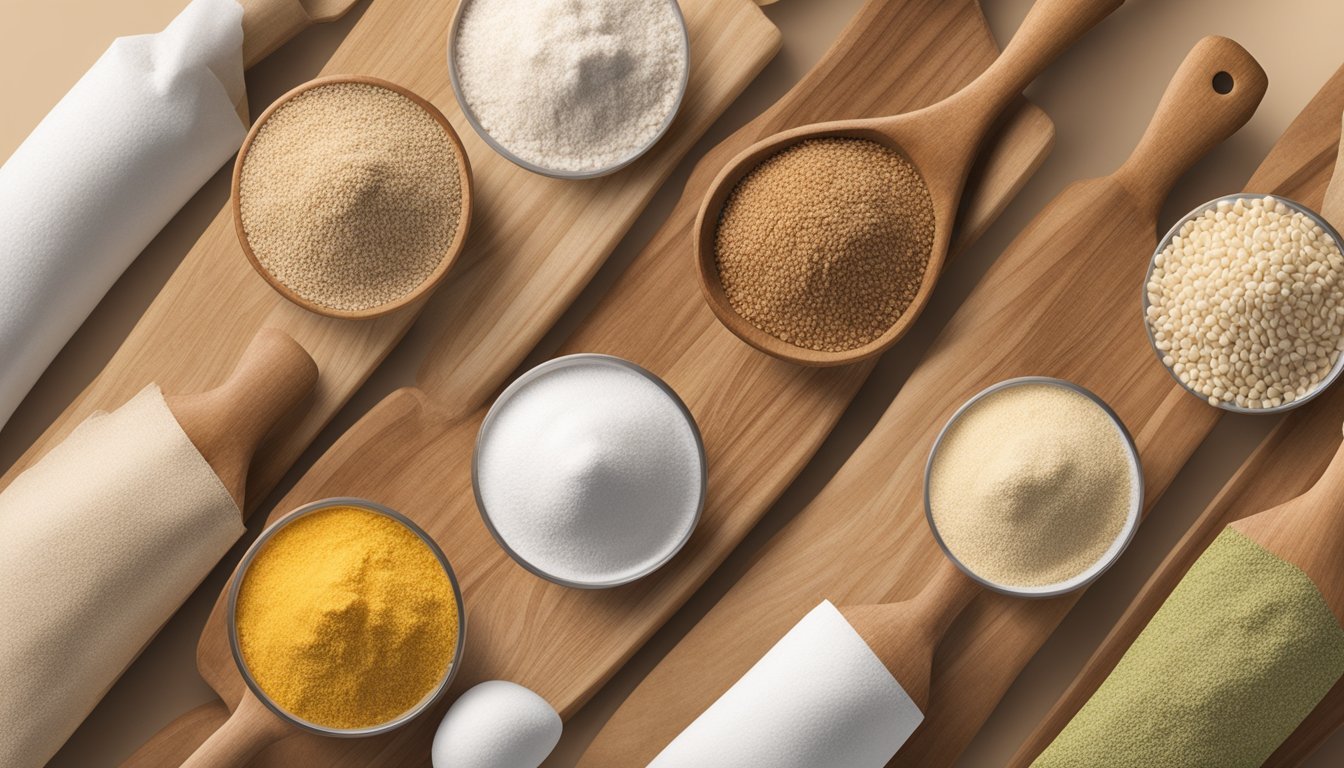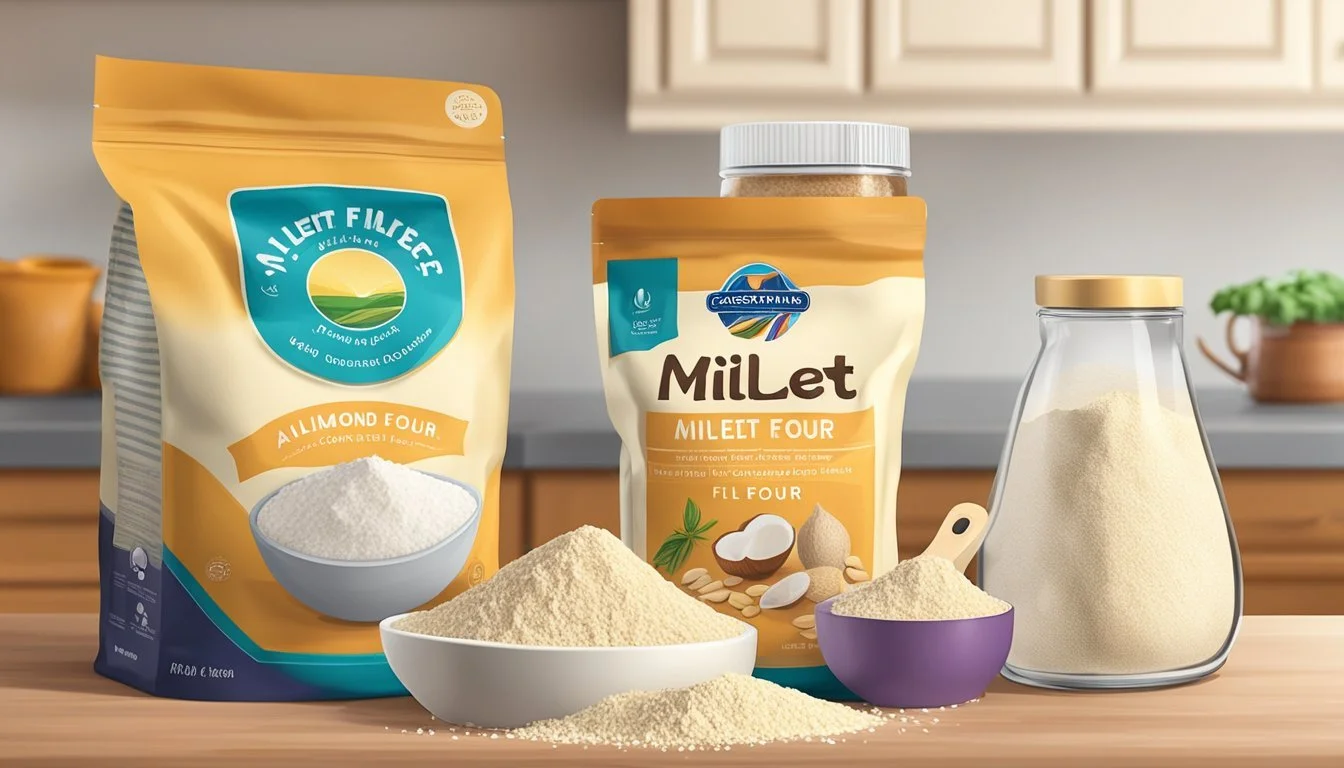Millet flour Substitutes
Top Alternatives for Baking and Cooking
Finding the perfect substitute for millet flour can be essential when gluten-free baking or cooking. If you're running low on millet flour or need an alternative, sorghum flour, quinoa flour, and oat flour are excellent options. Each of these substitutes brings its unique texture and nutritional benefits, making them suitable for various recipes.
Sorghum flour, for instance, not only shares a similar flavor profile with millet flour but is also packed with nutrients. Quinoa flour might require an additional egg or replacer, yet acts as a direct 1:1 substitution in most recipes. Oat flour stands out for its neutral taste and identical texture to millet flour, ensuring your dish retains its intended consistency and flavor.
Chickpea flour or garbanzo bean flour offers a slightly sweet, nutty taste, adding an extra layer of flavor to gluten-free baking. With these substitutes at your disposal, you can seamlessly replace millet flour in your recipes without compromising on taste or quality.
Understanding Millet Flour
Millet flour is a versatile and nutritious ingredient that's popular in gluten-free baking. Known for its slightly nutty flavor and fine texture, it adds a distinct character to various baked goods and dishes.
Nutritional Value
Millet flour is packed with essential nutrients. It is rich in protein, providing a good amount of this vital macronutrient for muscle maintenance and repair. It is also high in dietary fiber, which aids in digestion and promotes a feeling of fullness.
Vitamins found in millet flour include B vitamins like niacin, thiamine, and riboflavin. These help in energy metabolism and maintaining proper functioning of the nervous system. Minerals such as iron and magnesium are abundant in millet flour, supporting oxygen transport and bone health, respectively.
For people seeking a gluten-free diet, millet flour is an excellent choice as it naturally contains no gluten, making it suitable for those with celiac disease or gluten sensitivity.
Characteristics in Baking
Millet flour has a fine, light texture that works well in a variety of recipes. Its slightly nutty flavor can enhance the taste of baked goods, providing a subtle yet distinct taste profile. Bakers often appreciate its ability to combine well with other gluten-free flours like rice or sorghum flour to improve the texture and structure of the final product.
Due to its fine texture, millet flour can produce tender and crumbly baked goods. It is commonly used in making pancakes, muffins, and flatbreads. While it performs well in many recipes, it may require a binder such as xanthan gum or eggs when used alone to achieve the desired consistency and elasticity in doughs and batters.
Popular Millet Flour Substitutes
Millet flour has several excellent alternatives that can be used in various recipes, each bringing unique flavors and textures. These substitutes are categorized into whole grain, nut and seed flour, and starchy flour options.
Whole Grain Substitutes
Sorghum Flour: Sorghum flour is a versatile millet flour substitute often used in sweet baked goods, pancakes, and flatbreads. It has a mildly sweet flavor that complements desserts well. Sorghum flour also helps to thicken soups and make a roux.
Quinoa Flour: Quinoa flour has a slightly nutty taste and is rich in protein. It's a great option for gluten-free baking, adding both nutrition and a distinct flavor to bread, cookies, and muffins. Quinoa flour works well in combination with other flours.
Buckwheat Flour: Despite its name, buckwheat is a grain. Buckwheat flour has an earthy flavor that is ideal for pancakes, crepes, and bread. It is naturally gluten-free and provides a good source of fiber and nutrients.
Nut and Seed Flour Alternatives
Almond Flour: Almond flour is a popular choice for those seeking a gluten-free and protein-rich alternative. With its slightly sweet and nutty flavor, almond flour is perfect for baked goods such as cookies, cakes, and breads. It also adds a moist texture to recipes.
Chickpea Flour: Also known as garbanzo bean flour, chickpea flour is high in protein, fiber, and iron. It has a slightly sweet, nutty flavor and is great in gluten-free baking. Chickpea flour can be used in both sweet and savory dishes, including flatbreads and muffins.
Montina Flour: Made from Indian rice grass, Montina flour is less common but beneficial for gluten-free diets. It has a strong flavor that pairs well with other flours in baked goods. Montina flour can be used in bread, cookies, and as a thickening agent.
Starchy Flour Options
Oat Flour: Oat flour offers a neutral taste and a texture similar to millet flour, making it an excellent substitute. It's easy to find and works well in a variety of recipes, from cookies and cakes to breads and pancakes. Oat flour is also a good source of fiber.
Rice Flour: Rice flour is another versatile alternative, especially for those who need a gluten-free option. It has a mild flavor and fine texture, making it suitable for bread, pastries, and thickening soups or sauces. Both white rice flour and brown rice flour can be used.
Potato Starch: Potato starch is highly effective as a thickener and adds a light, airy texture to baked goods. It is mostly used in combination with other flours to improve the texture of recipes. This starch works well in gluten-free baking, offering a neutral taste.
Gluten-Free Alternatives for Specific Recipes
Various gluten-free flour alternatives can be used in place of millet flour, each suiting different types of recipes. Some stand out for bread and pizza dough, while others excel in cakes and muffins or savory dishes and soups.
Bread and Pizza Dough
For making bread and pizza dough, sorghum flour and chickpea flour are excellent choices. Sorghum flour, derived from whole grains, offers a slightly sweet and nutty flavor and ensures a good rise in the dough. It also adds a mild texture and nutritional benefits.
Chickpea flour provides a high protein and fiber content, making it ideal for bread and pizza dough. Its slightly sweet taste complements various toppings and fillings, creating a delicious and hearty base for savory dishes.
Rice flour is another suitable option, delivering a slightly chewy texture. It works well in combination with other gluten-free flours to create an elastic and pliable dough, ensuring that the end result closely mimics traditional wheat-based doughs.
Cakes, Muffins, and Sweet Baked Goods
When baking cakes, muffins, and other sweet treats, almond flour, oat flour, and sorghum flour are popular choices. Almond flour, made from ground almonds, provides a rich, nutty flavor and is low in carbs, making it perfect for keto-friendly recipes.
Oat flour has a neutral taste that doesn't interfere with the sweetness of baked goods. It is also known for its identical texture to millet flour, making it an easy substitution in most recipes.
Sorghum flour can be used in sweet baked goods like pancakes and cookies. It offers a slightly toasty aroma that enhances the flavor profile of desserts without overpowering the other ingredients.
Savory Dishes and Soups
For savory dishes, soups, and stews, chickpea flour and barley flour are great alternatives. Chickpea flour's high protein content makes it suitable for thickening soups and gravies, adding both consistency and depth of flavor.
Barley flour provides a hearty texture and is fantastic for thickening stews and soups. It adds a mildly earthy taste that enhances the overall flavor of the dish without being overbearing.
Sorghum flour can also be used to make a roux for gravies and sauces, providing smoothness and enhanced taste. Its versatility makes it a valuable addition to a variety of savory recipes.
Non-Gluten-Free Options
When searching for non-gluten-free alternatives to millet flour, there are several viable options that utilize wheat or other grains. These substitutes cater to those without gluten sensitivities and provide similar functionality to millet flour in various recipes.
Wheat-Based Flour Substitutes
All-Purpose Flour is the most commonly used substitute. It is versatile in baking and cooking. With a moderate gluten content, it adds structure to baked goods.
Whole Wheat Flour is another excellent option. It provides more nutrients and a richer flavor compared to refined white flour. Whole wheat flour works best in recipes for breads, muffins, and pancakes.
Rye Flour offers a distinct, slightly sour taste. It is particularly effective in bread recipes and pairs well with spices. The gluten content in rye flour is lower than in wheat flour but still sufficient for most baking needs.
Other Grain Flours
Barley Flour is a decent alternative. It is rich in fiber and adds a slightly sweet, nutty flavor to recipes. Due to its lower gluten content, it works well in combination with other flours.
Bulgur can also be considered in some cooking applications, though it is more commonly used in salads, pilafs, and tabbouleh. It brings a chewy texture and a nutty flavor.
Spelt Flour is another alternative. It is an ancient grain with a slightly sweet and nutty taste. Spelt flour has a comparable gluten content to wheat flour, making it suitable for bread and pastry recipes.
Considering Dietary Restrictions
When choosing a millet flour substitute, it's essential to consider dietary restrictions.
Celiac Disease and Gluten Intolerance: For those with celiac disease or gluten intolerance, gluten-free options are crucial. Almond flour and sorghum flour are optimal as they contain no gluten. Both are versatile, suitable for various baked goods, and maintain a pleasant taste.
Allergen Concerns: Certain substitutes, like almond flour, may not be suitable for individuals with nut allergies. Buckwheat flour can be a safer alternative, offering a nutty flavor without the risk of nuts. It works well in pancakes, bread, and other recipes.
Healthy Alternatives: For a healthy substitute, consider quinoa flour or buckwheat flour. Both are high in protein and provide essential nutrients. Quinoa flour is excellent for gluten-free baking, while buckwheat flour is known for its high fiber content, making it a nutritious choice.
When substituting millet flour, using the right quantity is key:
Substitute Ratio Notes Almond Flour 1 cup millet = ⅓ cup almond Ideal for baked goods and keto recipes Sorghum Flour 1:1 Suitable for sweet recipes and soups Buckwheat Flour 1:1 Great for a nut-free and healthy choice Quinoa Flour 1:1 High protein, best for gluten-free baking
Adjusting liquid levels in recipes might be necessary due to different moisture needs. Always check the texture to achieve the desired result.
How to Modify Recipes for Substitutes
When swapping millet flour for an alternative, several adjustments can help maintain the desired consistency, flavor, and binding properties in your recipe. Attention to liquid ratios, texture and flavor considerations, and thickening and binding agents are crucial for successful substitutions.
Adjusting Liquid Ratios
Different flours have varying absorbent properties, which affects moisture levels in recipes.
For example, almond flour often requires less liquid due to its high fat content. When using almond flour instead of millet flour, reduce the recipe’s liquid by about 25%.
Oat flour absorbs more moisture, so you may need additional liquid to prevent dryness. Add 1-2 tablespoons of water or milk at a time until the desired consistency is achieved.
Quinoa flour, often used as a 1:1 substitute, typically does not need major adjustments, but be aware of its binding needs.
Texture and Flavor Considerations
Each flour substitute brings its own unique texture and flavor.
Almond flour adds a moist, nutty flavor, making it ideal for baked goods but may not work well in recipes that require a neutral taste.
Sorghum flour, with its mild, sweet, and nutty flavor, resembles millet flour closely. It maintains a good texture in both baked and savory dishes.
Oat flour has a neutral flavor and a fine texture, making it suitable for most recipes without altering taste significantly.
Montina flour, though less common, has a mild flavor and works well where a subtle taste is required.
Thickening and Binding
Substitutes may need additional agents to maintain the structure and consistency of the original recipe.
Xanthan gum or guar gum can be added to assist in binding, especially when using flours like almond or oat flour. Typically, 1 teaspoon per cup of flour is sufficient.
Eggs or egg replacers are another effective binding option. When using quinoa flour, the addition of an extra egg can help bind and provide structure.
If using sorghum or oat flour, ground flaxseed or chia seeds mixed with water can create a gel-like consistency to help bind the ingredients together. Typically, use 1 tablespoon of ground flaxseed or chia seeds mixed with 3 tablespoons of water.
By carefully adjusting these elements, you can ensure that your recipe turns out well even when millet flour is replaced.
Health Benefits and Concerns
Exploring millet flour substitutes offers various health benefits and considerations. While many alternatives are nutrient-dense and beneficial for heart and digestive health, it's essential to understand the specific advantages and concerns associated with each choice.
Nutrient-Dense Choices
Several substitutes for millet flour provide a rich nutritional profile. Options like sorghum flour and almond flour are excellent choices due to their high vitamin and mineral content. Sorghum flour, for instance, is loaded with antioxidants and helps combat oxidative stress.
Almond flour is particularly noteworthy for its protein content and healthy fats. It also contains significant amounts of vitamin E, which acts as an antioxidant. These nutrient-dense alternatives can offer numerous health benefits while accommodating dietary restrictions like gluten-free needs.
Considerations for Heart and Digestive Health
When considering substitutes for millet flour, attention to fiber and overall digestive health is crucial. Buckwheat flour is one such alternative, known for its high dietary fiber, which aids in digestion and helps maintain heart health. Fiber can help lower cholesterol levels, reducing the risk of cardiovascular diseases.
Quinoa flour is another option that supports heart health due to its high protein content and presence of omega-3 fatty acids. These components help improve blood lipid profiles and reduce inflammation. Additionally, their gluten-free nature ensures that individuals with celiac disease or gluten intolerance can safely incorporate these flours into their diets.
Availability and Purchasing Tips
Finding millet flour substitutes can be quite simple, particularly when focusing on popular options like sorghum flour or almond flour.
In North America and South America, gluten-free flours are widely available in grocery stores and health food shops. Look for brands that specify "gluten-free" on their packaging to ensure they meet dietary requirements.
If montina flour is on your list, know that it can be more challenging to find. It's worth checking specialty stores or online retailers for this lesser-known option.
For a quick comparison of availability, consider the following table:
Flour Type Availability Comments Sorghum Easy to find Great for baking and thickening Almond Easy to find Low-carb and keto-friendly Montina Hard to find Specialty item in select markets Quinoa Easy to find Versatile for various dishes
When purchasing online, ensure you buy from reputable websites to get quality products. Always check the reviews and ratings before making a purchase.
For local stores, check the baking aisle or gluten-free section. If they're not available, ask store employees for recommendations on similar products.
Having these tips in mind can make locating good substitutes for millet flour easier, whether for dietary needs or culinary experiments.







